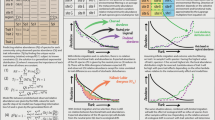Abstract
Arising from: I. Volkov, J. R. Banavar, F. He, S. P. Hubbell & A. Maritan Nature 438, 658–661 (2005); Volkov et al. reply.
Ecologists are struggling to explain how so many tropical tree species can coexist in tropical forests, and several empirical studies have demonstrated that negative density dependence is an important mechanism of tree-species coexistence1,2. Volkov et al.3 compare a model incorporating negative density dependence with a dispersal-limited neutral model4 and claim that each predicts six empirical species-abundance distributions of tropical-tree communities equally well. However, we show here that their main conclusion is premature: when the two models are compared in an improved analysis, we find that the dispersal-limited model outcompetes the density-dependent model in all six cases. Hence, although density dependence is certainly an important diversity-maintaining mechanism, our improved approach indicates that the dispersal-limited model provides a more parsimonious explanation of empirical species-abundance distributions.
Similar content being viewed by others
Main
Volkov et al. compare model performances by applying a maximum-likelihood method to empirical species-abundance distributions. They use an approximate-likelihood function5, but an exact likelihood is now available for the dispersal-limited model that is based on a proper sampling theory6,7. We applied the new maximum-likelihood method to the data sets used by Volkov et al. and based our model comparison on the difference in the models' AIC, defined as twice the number of parameters in the model minus twice its maximum log-likelihood8.
We found that the dispersal-limited model performed significantly better than the density-dependent model for all six forests (Table 1). The probability that the density-dependent model performed better than the dispersal-limited model (mathematically defined as the Akaike weight8) was always less than 1%. Even a dispersal-unlimited neutral model performed better than the density-dependent model in two cases out of six. Thus the claim by Volkov et al. that density dependence gives an equally sufficient mechanistic explanation for species-abundance distributions, in addition to and independent of dispersal limitation, is unsubstantiated.
How can one test the claim of Volkov et al. that alternative models cannot be distinguished, in principle or in practice, given just the species-abundance distributions? Volkov et al. support their assertion by arguing that the ratio r̂n, computed from the expected number of species with a given abundance3, looks the same for all models when plotted against n. However, they do not convincingly show that these graphs are statistically indistinguishable. Even if they had, this would still be a weak test of model equivalence. Proving that two species-abundance models are mathematically equivalent requires construction of the multivariate distribution for species abundances under the density-dependent model, as well as evidence that this distribution is mathematically equal to that derived in ref. 6. If so, the two models would indeed be indistinguishable. If the models are not mathematically equivalent, they may still be statistically equivalent in most practical situations. Proving statistical equivalence requires a case-by-case comparison of the models' exact likelihood functions, as outlined here.
Our analysis provides evidence in favour of the dispersal-limited model, and contradicts the claim of Volkov et al.3. However, the authors' density-dependent model in its current formulation lacks a suitable sampling theory with an exact-likelihood function, and hence precludes any definitive answer about the fundamental or practical equivalence of alternative models. Although Volkov et al. have made a useful contribution by emphasizing the value of simple models in ecology, further theoretical developments aimed at exploring the contribution of density dependence to patterns of species diversity are needed9,10.
References
Harms, K. E., Wright, S. L., Calderón, O., Hernandez, A. & Herre, E. A. Nature 404, 493–495 (2000).
Packer, A. & Clay, K. Nature 404, 278–281 (2000).
Volkov, I., Banavar, J. R., He, F., Hubbell, S. P. & Maritan, A. Nature 438, 658–661 (2005).
Hubbell, S. P. The Unified Neutral Theory of Biodiversity and Biogeography. (Princeton Univ. Press, Princeton, New Jersey, 2001).
Alonso, D. & McKane, A. J. Ecol. Lett. 7, 901–910 (2004).
Etienne, R. S. Ecol. Lett. 8, 253–260 (2005).
Etienne, R. S. & Alonso, D. Ecol. Lett. 8, 1147–1156 (2005).
Burnham, K. P. & Anderson, D. R. Model Selection and Multimodel Inference 2nd edn (Springer, New York, 2002).
Engen, S. & Lande, R. Math. Biosci. 132, 169–183 (1996).
Diserud, O. & Engen, S. Am. Nat. 155, 497–511 (2000).
Author information
Authors and Affiliations
Rights and permissions
About this article
Cite this article
Chave, J., Alonso, D. & Etienne, R. Comparing models of species abundance. Nature 441, E1 (2006). https://doi.org/10.1038/nature04826
Published:
Issue Date:
DOI: https://doi.org/10.1038/nature04826
This article is cited by
-
A niche remedy for the dynamical problems of neutral theory
Theoretical Ecology (2015)
-
Interactions, Environmental Sorting and Chance: Phylostructure of a Tropical Forest Assembly
Folia Geobotanica (2014)
-
The neutral theory of biodiversity with random fission speciation
Theoretical Ecology (2011)
-
The effects of intraspecific density dependence on species richness and species abundance distributions
Theoretical Ecology (2011)
-
Relative roles of niche and neutral processes in structuring a soil microbial community
The ISME Journal (2010)
Comments
By submitting a comment you agree to abide by our Terms and Community Guidelines. If you find something abusive or that does not comply with our terms or guidelines please flag it as inappropriate.



